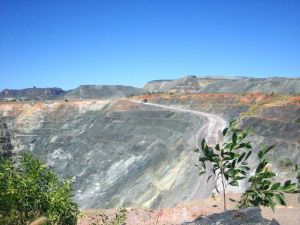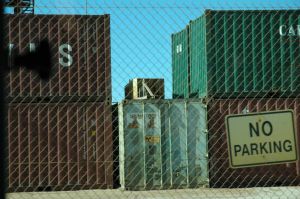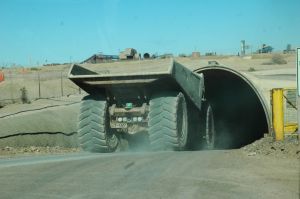Uranium
Uranium Reserves
The world's biggest uranium reserves are currently located in Canada, Australia, Kazakhstan, Russia, Niger, Namibia, and Uzbekistan.[1]
In Europe today no uranium is mined apart from small amounts in the Czech Republic and Romania.[1]
Since the world market price of uranium oxide (U3O8) has been tripled between 2000 and 2003 to 66 EUR per kilogram a new run to exploit even poor uranium reserves has been started[2]. Additionally according to the IAEA the demand for uranium is much higher than the uranium mined worldwide since many years. By now this demand could be substituted by the old nuclear weapon's fission materials, but this "resource" will be mostly exploited soon.
Closed Uranium Mines
Germany
- Former GDR: Wismut[3]
- was the 3rd biggest uranium producer in the world until 1990[1]
- in operation: 1946-1990
- underground and open cast mining of uranium in former GDR
- 1,200 million tons extracted mineral mass
- 200 million tons processed
- 1,000 million tons tailings
- about 500,000 persons occupied
- 15,000 accepted cases of silicosis (German: "Staublunge")
- 5,600 accepted cases of lung cancer
- reclamation costs: 7.5 billion EUR (publically paied)
- tailings have been covered, mines filled
- Former FRG: Menzenschwand[1]
- located in the Schwarzwald in Western Germany - was a very small uranium mine until 1991
France
- 210 uranium mines have been closed until 2001[1]
Portugal
- 1909 the first licence for uranium mining was granted; after World War II the Portuguese uranium oxide was delivered as well to the British as to the US nuclear industry[4]
- by 1991 62 uranium mines have been exploited in Portugal[4]
- Urgeiriça (near Viseu): closed in 1991[4]
Uranium Mines in Operation
Australia
- Olympic Dam[5]:
- Olympic Dam, located in the South Australian desert outside the town of Roxby Downs, is Australia's biggest uranium resource. The mine is on the land of the Kokatha people and draws water from the land of the Arabunna people.
- In 2005 BHP Billiton (BHPB) took over Western Mining Corporation inheriting not only ownership of Olympic Dam but the Roxby Indenture Act. This allows for extravafant exceptions to environmental and cultural heritage legislation protection.
- BHPB plans to make Olympic Dam the largest open-cut mine in the world by digging a pit of about 20 cubic kms. Export of uranium is expected to increase from an average of 4000 tonnes per year to 19,000 tonnes per year and production of copper, gold and silver is also expected to increase.
- Tailings: The production of radioactive tailings, stored above ground, will increase to 70 million tonnes annually. Currently, tailings are producted at a rate of 10 million tonnes annually and the stockpile amounts to 100 million tonnes. The tailings dam contain a toxic, acidic soup of radionuclides and heavy metals and are responsible for large numbers of bird deaths - over 100 deaths in a four-days period in 2004. There have been numerous spills and leaks - most significantly in 1994, when it was revealed that three billion litres had leaked from the tailings dams over two years.
- Water: BHP Billiton proposes an increase in water consumption from 35 million litres daily (from the Great Artesian Basin) to 150 million litres daily (up to 42 million litres from the Great Artesian Basin, the remainder from a proposed desalination plant at Port Bonython). The water take from the Great Artesian Basin had adverse impacts on the precious Mound Springs and needs to be reduced or stopped altogether. BHP Billiton pays nothing for its massive water take despite recording a profit of A$ 22 billion in 2007/08.
- Electricity: Electricity demand for the mine will increase from 120 megawatts to 690 megawatts - equivalent to 42 % of South Australia's current total electricity consumption. Electricity will be supplied from the SA grid and/or an on-site gas-fired plant, with no government requirement or company plans for any electricity to be supplied from renewable energy sources.
- Nuclear Weapons Proliferation: There is an unacceptable risk of uranium from Roxby Downs finding its way into nuclear weapons. Accounting discrepancies involving Australia's uranium exports are common. International Atomic Energy Agency Director-General Dr. Mohamed El Baradei has acknowledged that the IAEA's rights of inspection are "fairly limited", that the 'safeguards' system is subject to "vulnerabilities" and "clearly needs reinforcement", that efforts to improve the system have been "half-hearted", and that the safeguards system operates on a "shoestring budget ... comparable to a local police department". Uranium production at Roxby is expected to increase to 19,000 tonnes per year, sufficient to fuel 95 power reactors which will produce 18.5 tonnes of plutonium each year - enough for 2,850 nuclear weapons each year.
Proposed Uranium Mines
Portugal
- Nisa: near to the 3,600 inhabitants city the biggest not yet exploited uranium resource is situated; it had already been discovered in 1959; about six million tons of uranium ore can be found here - enough to produce some 650 tons of uranium oxide[4]
Uranium Facts
- Volumes of greenhouse gases are emitted throughout the nuclear chain from mining, milling, transporting, building nuclear power plants and reprocessing uranium for use in weapons and nuclear power.[5]
- Uranium is the heaviest of all minerals. The percentage of uranium to ore is quite small in commercially mined uranium, averaging 0.3 % in Australia but as high as 15 % in Canada. The ore is, therefore, milled to concentrate the uranium, resulting in a marketable product, uranium oxide (U3O8), also known as 'yellowcake'.[5]
- Uranium isotopes remain radioactive for millions of years:[5]
- U238: (also known as depleted uranium) has a half-life (the time it takes for it to lose half its radioactivity) of 4.5 billion years
- U235: 704 million years
- U234: 245,000 years
- Radon is a radioactive gas released from uranium decay.[5]
- In Australia three kinds of mining process are used to extract uranium: underground (as currently used at Olympic Dam), surface (open pit, as used at Ranger), or acid solution/in-situ leach (as used at Beverley).
Information
- WISE Uranium Project - WISE Uranium Project is part of World Information Service on Energy. It covers the health and environmental impacts of nuclear fuel production
- uranium network English/German
- Uranium Watch - a Urah / USA based information service on Uranium
- SEA-US Inc. - The sustainable energy & anti-uranium service
Local Resistance
- Ranua Rescue project Finnish
- Swedish Anti Uranium Network Swedish
- Movimento Não a Opção Nuclear Portuguese
- Nianfors resistance against uranium mining (SE) English/Swedish
- Roxstop Action against the Olympic Dam mine in Australia English
Materials
- Der schmutzige Atombrennstoff German
- Nuking The Climate - Movie about uranium mining English/German
- Uranium Mining "Slide Talk" - online slideshow presentation English
- Roxstop Action Kit -Information about uranium mining, the Olympic Dam mine in Australia and how to become active against it English
Action
Uranium Mining Images
Uranium Mining in Australia
- Sample gallery
Olympic Dam Mine
- Sample gallery
Container with Yellow Cake (Uraniumoxide)
http://strahlendesklima.deConveyor belt
http://strahlendesklima.deTruck driving into the uranium mine
http://strahlendesklima.deWinding tower
http://strahlendesklima.deWinding tower
http://strahlendesklima.deConveyor belt
http://strahlendesklima.deWinding tower
http://strahlendesklima.deNuclear caution signs
http://strahlendesklima.deNuclear caution sign
http://strahlendesklima.deNuclear caution sign + workers
http://strahlendesklima.deNuclear worker
http://strahlendesklima.deNuclear caution sign
http://strahlendesklima.deNuclear caution sign
http://strahlendesklima.deNuclear caution signs on containers
http://strahlendesklima.deContainers with Yellow Cake
http://strahlendesklima.deConveyor belt
http://strahlendesklima.deNuclear workers
http://strahlendesklima.deNuclear caution sign
http://strahlendesklima.deTailing Ponds with nuclear waste
http://strahlendesklima.deNuclear caution sign
http://strahlendesklima.de
Ranger Mine
- Sample gallery
Open pit mine
http://strahlendesklima.deTruck probably with uranium ore
http://strahlendesklima.deConveyor belt
http://strahlendesklima.deWater supply for the uranium mine
http://strahlendesklima.deWater pipeline for the uranium mine
http://strahlendesklima.deUranium truck
http://strahlendesklima.deOld sign with information for emergency cases (contamination of people)
http://strahlendesklima.deNuclear caution sign
http://strahlendesklima.deWater supply for the uranium mine
http://strahlendesklima.de
Uranium Mining in India
- Sample gallery
Uranium Companies
Finde more articles about Uranium on the Nuclear Heritage Network webpage.
- ↑ 1.0 1.1 1.2 1.3 1.4 .ausgestrahlt: Der schmutzige Atom-Brennstoff. Fragen und Antworten zur Herkunft des Urans. Mai 2009
http://www.ausgestrahlt.de/fileadmin/user_upload/luki/der-schmutzige-atombrennstoff.pdf - ↑ Cite error: Invalid
<ref>tag; no text was provided for refs namedNorbertSuchanek - ↑ Source: lecture "Health effects of uranium mining workers and residents, the experience in Germany" of Prof. Inge Schmitz-Feuerhake at the expert hearing on uranium effects in Ranua on November 7th, 2009
- ↑ 4.0 4.1 4.2 4.3 Norbert Suchanek: Kein Uranbergbau im Alentejo - Portugals radioaktives Erbe (November 2009)
- ↑ 5.0 5.1 5.2 5.3 5.4 http://www.roxstop-action.org/Booklet_16pp.pdf , November 17, 2009















































































